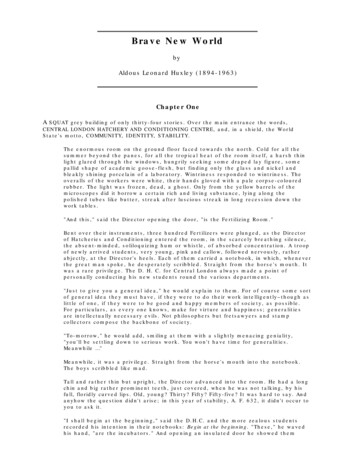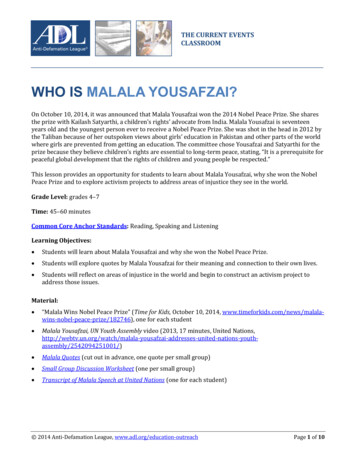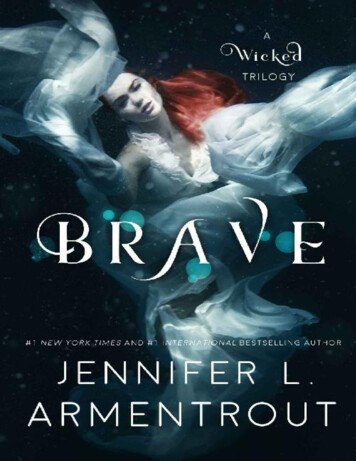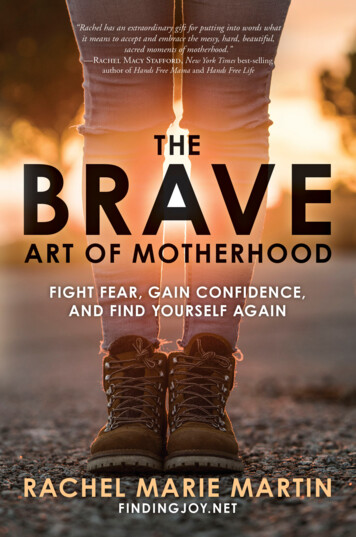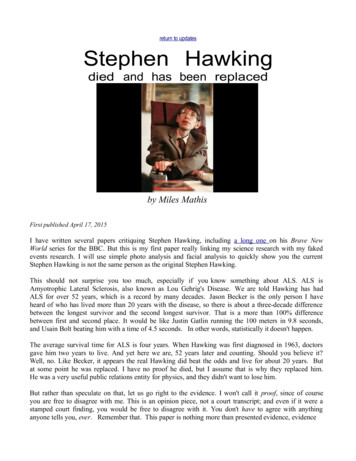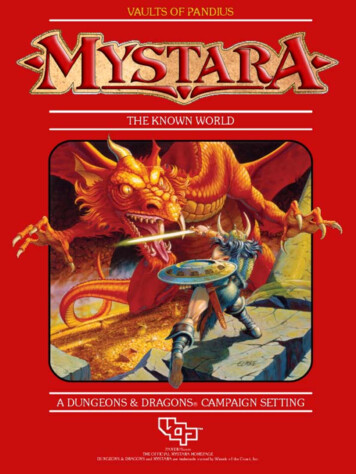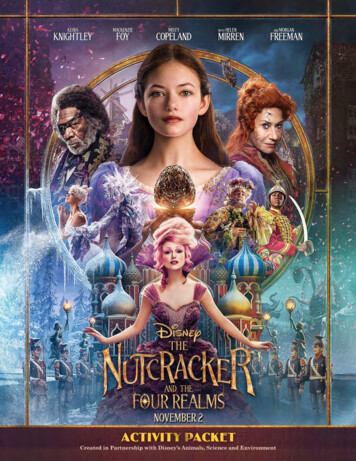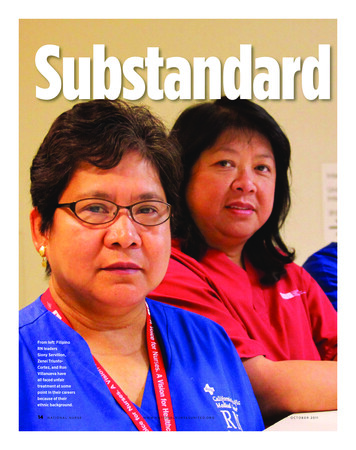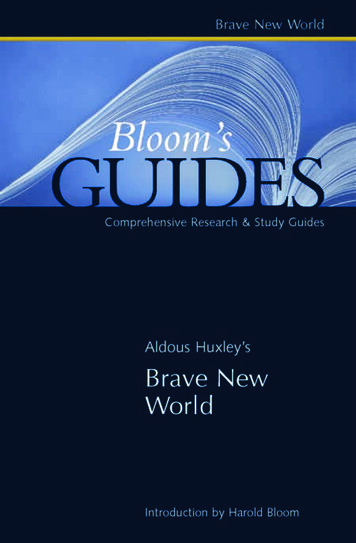
Transcription
Bloom’sGUIDESAldous Huxley’sBraveNew World
CURRENTLY AVAILABLE1984All the Pretty HorsesBelovedBrave New WorldCry, the Beloved CountryDeath of a SalesmanHamletThe Handmaid’s TaleThe House on Mango StreetI Know Why the Caged Bird SingsThe Scarlet LetterTo Kill a Mockingbird
Bloom’sGUIDESAldous Huxley’sBraveNew WorldEdited & with an Introductionby Harold Bloom
2004 by Chelsea House Publishers, a subsidiary of Haights CrossCommunications.Introduction 2004 by Harold Bloom.All rights reserved. No part of this publication may be reproducedor transmitted in any form or by any means without the writtenpermission of the publisher.Printed and bound in the United States of America.First Printing135798642Library of Congress Cataloging-in-Publication DataApplied ForISBN: 0-7910-7566-4Chelsea House Publishers1974 Sproul Road, Suite 400Broomall, PA 19008-0914www.chelseahouse.comContributing editor: Aislinn GoodmanCover design by Takeshi TakahashiLayout by EJB Publishing Services
ContentsIntroductionBiographical SketchThe Story Behind the StoryList of CharactersSummary and AnalysisCritical ViewsPeter Bowering on Huxley’s Use of SomaJerome Meckier on Huxley’s Ironic UtopiaLaurence Brander on the “Mass Community”Peter Firchow on Satirical versusFuturistic ReadingsIra Grushow on Brave New Worldand The TempestPeter M. Larsen on Huxley’s Useof “Synthetic Myths”Robert S. Baker on the Evolutionof Huxley’s PhilosophyRafeeq O. McGiveron on the Literaryand Political Allusions behind Huxley’sChoice of NamesGuinevera A. Nance on the Limits of the HeroicMalinda Snow on Huxley’s Use of ThomasGray’s “Elegy Written in a Country Church Yard”Works by Aldous HuxleyAnnotated 197070727579828589929597101104108110112
IntroductionHAROLD BLOOMIn his “Foreword” to a 1946 edition of Brave New World (1931),Aldous Huxley expressed a certain regret that he had writtenthe book when he was an amused, skeptical aesthete rather thanthe transcendental visionary he had since become. Fifteen yearshad brought about a world in which there were “onlynationalistic radicals of the right and nationalistic radicals ofthe left,” and Huxley surveyed a Europe in ruins after thecompletion of the Second World War. Huxley himself hadfound refuge in what he always was to call “the PerennialPhilosophy,” the religion that is “the conscious and intelligentpursuit of man’s Final End, the unitive knowledge of theimmanent Tao or Logos, the transcendent godhead orBrahman.” As he sadly remarked, he had given his protagonist,the Savage, only two alternatives: to go on living in the BraveNew World whose God is Ford (Henry), or to retreat to aprimitive Indian village, more human in some ways, but just aslunatic in others. The poor Savage whips himself into thespiritual frenzy that culminates with his hanging himself.Despite Huxley’s literary remorse, it seems to me just as wellthat the book does not end with the Savage saving himselfthrough a mystical contemplation that murmurs “That areThou” to the Ground of All Being.A half-century after Huxley’s “Foreword,” Brave New Worldis at once a bit threadbare, considered strictly as a novel, andmore relevant than ever in the era of genetic engineering,virtual reality, and the computer hypertext. Cyberpunk sciencefiction has nothing to match Huxley’s outrageous inventions,and his sexual prophecies have been largely fulfilled. Whetherthe Third Wave of a Gingrichian future will differ much fromHuxley’s Brave New World seems dubious to me. A newtechnology founded almost entirely upon information ratherthan production, at least for the elite, allies Mustapha Mondand Newt Gingrich, whose orphanages doubtless can be geared7
to the bringing up of Huxley’s “Bokanovsky groups.” EvenHuxley’s intimation that “marriage licenses will be sold like doglicenses, good for a period of twelve months,” was beingseriously considered in California not so long ago. It is truethat Huxley expected (and feared) too much from the“peaceful” uses of atomic energy, but that is one of his fewfailures in secular prophecy. The God of the ChristianCoalition may not exactly be Our Ford, but he certainly is theGod whose worship assures the world without end of BigBusiness.Rereading Brave New World for the first time in severaldecades, I find myself most beguiled by the Savage’s passion forShakespeare, who provides the novel with much more than itstitle. Huxley, with his own passion for Shakespeare, would nothave conceded that Shakespeare could have provided theSavage with an alternative to a choice between an insane utopiaand a barbaric lunacy. Doubtless, no one ever has been saved byreading Shakespeare, or by watching him performed, butShakespeare, more than any other writer, offers a possiblewisdom, as well as an education in irony and the powers oflanguage. Huxley wanted his Savage to be a victim orscapegoat, quite possibly for reasons that Huxley himself neverunderstood. Brave New World, like Huxley’s earlier and betternovels Antic Hay and Point Counter Point, is still a vision of T. S.Eliot’s Waste Land, of a world without authentic belief andspiritual values. The author of Heaven and Hell and theanthologist of The Perennial Philosophy is latent in Brave NewWorld, whose Savage dies in order to help persuade Huxleyhimself that he needs a reconciliation with the mystical Groundof All Being.8
Biographical SketchAldous Leonard Huxley was born on July 6, 1894, inGodalming in Surrey, England. He came from a family ofdistinguished scientists and writers: his grandfather wasThomas Henry Huxley, the great proponent of evolution, andhis brother was Julian Sorrell Huxley, who became a leadingbiologist. Aldous attended the Hillside School in Godalmingand then entered Eton in 1908, but he was forced to leave in1910 when he developed a serious eye disease that left himtemporarily blind. In 1913 he partially regained his sight andentered Balliol College, Oxford.Around 1915 Huxley became associated with a circle ofwriters and intellectuals who gathered at Lady OttolineMorell’s home, Garsington Manor House, near Oxford; herehe met T. S. Eliot, Bertrand Russell, Osbert Sitwell, and otherfigures. After working briefly in the War Office, Huxleygraduated from Balliol in 1918 and the next year beganteaching at Eton. He was, however, not a success there anddecided to become a journalist. Moving to London with hiswife Maria Nys, a Belgian refugee whom he had met atGarsington and married in 1919, Huxley wrote articles andreviews for the Athenaeum under the pseudonym Autolycus.Huxley’s first two volumes were collections of poetry, but itwas his early novels—Crome Yellow (1921), Antic Hay (1923), andThose Barren Leaves (1925)—that brought him to prominence. By1925 he had also published three volumes of short stories andtwo volumes of essays. In 1923 Huxley and his wife and sonmoved to Europe, where they traveled widely in France, Spain,and Italy. A journey around the world in 1925–26 led to thetravel book Jesting Pilate (1926), just as a later trip to CentralAmerica produced Beyond the Mexique Bay (1934). Point CounterPoint (1928) was hailed as a landmark in its incorporation ofmusical devices into the novel form. Huxley developed afriendship with D. H. Lawrence, and from 1926 until Lawrence’sdeath in 1930 Huxley spent much time looking after him duringhis illness with tuberculosis; in 1932 he edited Lawrence’s letters.9
In 1930 Huxley purchased a small house in Sanary, insouthern France. It was here that he wrote one of his mostcelebrated volumes, Brave New World (1932), a negative utopiaor “dystopia” that depicted a nightmarish vision of the future inwhich science and technology are used to suppress humanfreedom.Huxley became increasingly concerned about the state ofcivilization as Europe lurched toward war in the later 1930s: heopenly espoused pacifism and (in part through the influence ofhis friend Gerald Heard) grew increasingly interested inmysticism and Eastern philosophy. These tendencies wereaugmented when he moved to southern California in 1937.With Heard and Christopher Isherwood, Huxley formed theVedanta Society of Southern California, and his philosophy wasembodied in such volumes as The Perennial Philosophy (1945)and Heaven and Hell (1956).During World War II Huxley worked as a scenarist inHollywood, writing the screenplays for such notable films asPride and Prejudice (1941) and Jane Eyre (1944). This experienceled directly to Huxley’s second futuristic novel, Ape and Essence(1948), a misanthropic portrait of a post-holocaust societywritten in the form of a screenplay.In California Huxley associated with Buddhist and Hindugroups, and in the 1950s he experimented with hallucinogenicdrugs such as LSD and mescalin, which he wrote about in TheDoors of Perception (1954). Brave New World Revisited (1958), abrief treatise that discusses some of the implications of hisearlier novel, continues to be very pessimistic about the futuresociety, particularly in the matters of overpopulation and thethreat of totalitarianism. But in Island (1962)—the manuscriptof which Huxley managed to save when a brush fire destroyedhis home and many of his papers in 1961—he presents apositive utopia in which spirituality is developed in conjunctionwith technology.Late in life Huxley received many honors, including anaward from the American Academy of Letters in 1959 andelection as a Companion of Literature of the British RoyalSociety of Literature in 1962. His wife died in 1955, and the10
next year he married Laura Archera, a concert violinist. AldousHuxley died of cancer of the tongue on November 22, 1963,the same day as John F. Kennedy and C. S. Lewis.11
The Story Behind the StoryAldous Huxley’s decision to merge science with literatureseems an obvious choice when one considers his heritage. Bornin 1894 in Surrey, England, Huxley’s father, Leonard Huxley,was editor of Cornhill magazine, a literary journal thatpublished authors such as George Eliot, Thomas Hardy,Alfred, Lord Tennyson and Robert Browning. His mother,Julia Arnold, was the niece of the poet Matthew Arnold, andher sister, Mary Humphrey Ward, was a popular novelist in herown right. Huxley’s grandfather was the famous biologist T. H.Huxley, Charles Darwin’s disciple and protégé.As it was proper for the son of two such distinguishedintellectual families, Huxley attended Eton with the hopes offollowing in the footsteps of his grandfather and elder brotherJulian by becoming a doctor and scientist. Such dreams weredashed when Huxley was sixteen, as he contracted a seriousdisease that left him completely blind for two years, andseriously damaged his vision for the rest of his life. Huxleychanged career paths and in 1916, received his undergraduatedegree in literature from Balliol College, Oxford.Huxley began writing professionally in 1920 for variousmagazines, and published his first novel, Crome Yellow, in 1920at the age of twenty-six. His satirical voice was well-received,and went on to publish several more novels, producing PointCounter Point in 1928, establishing himself as a best-sellingauthor. Although it has not been Huxley’s most enduring novel,many critics believe Point Counter Point to be his mostambitious and successful work. It was on the heels of thissuccess that Huxley produced Brave New World.Brave New World sold 13,000 copies in England in its firstyear, 3000 more than Point Counter Point. But although the novelwas a success in terms of sales, reviews were uniformly negative.A departure from his previously lively, “carnivalesque” style,critics accused Brave New World of being dry, boring, andoverly simplistic. His vision of the future was seen asinteresting but irrelevant and unoriginal. In his journal Books,12
M. C. Dawson called the novel “a lugubrious and heavyhanded piece of propaganda.” Illustrating the attitude of manyreviewers, the following is an excerpt from the New Statesmanand Nation:[T]his squib about the future is a thin little joke,epitomized in the undergraduate jest of a civilizationdated A.F., and a people who refer reverently to ‘ourFord’—not a bad little joke, and what it lacks in richnessMr. Huxley tries to make up by repetition; but we wantrather more to a prophecy than Mr. Huxley gives us .The fact is Mr. Huxley does not really care for the story—the idea alone excites him. There are brilliant, sardoniclittle splinters of hate aimed at the degradation he hasforeseen for our world; there are passages in which heelaborates conjectures and opinions already familiar toreaders of his essays . There are no surprises in it; and ifhe had no surprises to give us, why should Mr. Huxleyhave bothered to turn this essay in indignation into anovel?The reviewer finds “prophecy” in Huxley’s novel, and isdisappointed with the simplicity of it. But Huxley insisted thatBrave New World was not a prophetic novel, but a cautionaryone. He saw the rapid changes that scientific advancement wasallowing in his society and, aided by a strong scientificbackground, imagined how much further it might go. In a 1962interview, Huxley defends his purpose in writing the novel:[Technology could] iron [humans] into a kind of uniformity,if you were able to manipulate their genetic background .if you had a government unscrupulous enough you could dothese things without any doubt . We are getting more andmore into a position where these things can be achieved.And it’s extremely important to realize this, and to takeevery possible precaution to see they shall not be achieved.This, I take it, was the message of the book—This is possible:for heaven’s sake be careful about it.13
Another complaint was Huxley’s “preoccupation withsexuality.” The promiscuity of Huxley’s futuristic society, andthe ease with which he discusses it, was shocking anddisturbing. A reviewer from London’s Times LiterarySupplement wrote “it is not easy to become interested in thescientifically imagined details of life in this mechanical Utopia.Nor is there compensation in the amount of attention that[Huxley] gives to the abundant sex life of these denaturedhuman beings.”It is also worth noting that Huxley composed Brave NewWorld in 1931, when Europe and America were still reeling—economically, politically, and socially—from World War I.Massive industrialization, coupled with severe economicdepression and the rise of fascism, were the backdrop for thenovel. It was this turbulence that informed Huxley’s cautionaryvision of the future. But the massive destruction of World WarII was yet to be seen, and Huxley’s imagined history of theNine Years’ War and the persecution that followed might haveseemed a bit fantastical.A decade later, the strength of fascist states such as NaziGermany and the Soviet Union, coupled with the terror ofWorld War II, radically changed the world’s vision of futurepossibilities. Huxley’s warning of an all-powerful governmentwas more relevant than Mr. Dawson thought in 1932. In thesecond half of the twentieth century, advances in biology wereso vast that a eugenic society became more than a madEnglishman’s far-fetched fantasy. And today, with thedevelopment of successful experiments in cloning, Huxley’s taleof caution has somehow morphed into one of prophecy. EvenHuxley, in his introduction to Brave New World written in 1946,admits:All things considered it looks as though Utopia were farcloser to us than anyone, only fifteen years ago, couldhave imagined. Then, I projected it six hundred years intothe future. Today it seems quite possible that the horrormay be upon us within a single century . Indeed, unlesswe choose to decentralize and to use applied science, not14
as the end to which human beings are to be made themeans, but as the means to producing a race of freeindividuals, we have only two alternatives to choose from:either a number of national, militarized totalitarianisms,having as their root the terror of the atomic bomb and astheir consequence the destruction of civilization . or elseone supranational totalitarianism, called into existence bythe social chaos resulting from rapid technologicalprogress in general and the atomic revolution inparticular, and developing, under the need for efficiencyand stability, into the welfare-tyranny of Utopia. You paysyour money and you takes your choice.Each decade brings its technological advances, and theseadvances inexorably alter the social fabric of the world. Perhapshis guesses were simply lucky, but Huxley’s Utopia seems closerevery day. This ability of Brave New World to become morerelevant as time passes accounts for its continual popularity,both as a period piece and as an ever-modern novel.15
List of CharactersThe Director of Hatcheries and Conditioning for CentralLondon is the head of the Central Hatchery where many of thecharacters work and much of the narrative takes place. Heintroduces the reader to the facility and the fundamentals ofHuxley’s futuristic society. It is the Director’s accident whilevisiting the Savage Reservation years earlier that provides theimpetus for the second half of the novel.Henry Foster is one of Lenina’s boyfriends, and accompaniesthe Director on the student tour of the Central Hatchery andConditioning Center in the first section of the novel. He servesas a counterpoint to Bernard Marx—where Bernard is antisocial, eccentric, and individual, Henry is the modelconditioned citizen.Lenina Crowne works in the Central Hatchery andConditioning Centre, and accompanies Bernard to the SavageReservation in New Mexico. Her beauty attracts John, and shebecomes the object of his romantic and possessive love. Sheserves as the liaison between civilized and savage society, as shefeels a strong connection for John but is confused by whatseems to be a growing predilection for monogamy and love.John’s attraction to her, and her inability to abandon thepromiscuous dictates of her conditioning, serves as a majorconflict during John’s visit to London.Mustapha Mond is one of ten World Controllers, and hissphere of influence includes England. His position as one ofthe major upholders of conditioned society is complicated byhis understanding of the sacrifice necessary for such a strictsociety; his secret stash of forbidden religious and literary texts,as well as his personal history as a young man faced with exileor the renunciation of his pursuit of knowledge, demonstratethat individual awareness has not been eradicated in the“civilized” world, but merely suppressed.16
Bernard Marx is an example of unsuccessful, or incomplete,conditioning. Perhaps due to an accident of his conditioningwhile he was still “bottled,” Bernard is physically imperfect,melancholy, and dissatisfied with life in London. Rather thanregularly taking soma and engaging in state-supervisedentertainment, he complains about London’s lack ofindividuality and feels an outsider in a society that purports toabolish self-consciousness. He is responsible for bringing Johnand Linda to London, and is finally exiled as a result of hispredilection for criticism of the state.Fanny Crowne also works in the Conditioning Centre, and isLenina’s friend. She serves as a warning voice when Leninaexhibits a desire for monogamy, first with Henry Foster andlater with John. When Lenina considers the strange passionshe feels for John, Fanny counsels her to date and sleep withhim, and explains Lenina’s surprising depression as evidencethat she needs a Violent Passion Surrogate. Like Henry, Fannyis a model citizen, and cannot contemplate behaving againsther conditioning.Helmholtz Watson feels like an outsider in conditioned society.He writes propaganda for several state-sanctioned publications,but longs to write something more meaningful and passionate.He immediately befriends John, and is enthralled by theforbidden writings of Shakespeare (which John reveals to him).Like Bernard, he is ultimately exiled by Mond to the FalklandIslands where he can pose no threat to the stability ofconditioned society; unlike Bernard, Helmholtz anticipates hisexile as an opportunity to escape the limited society of Londonand looks forward to having the freedom to explore hisindividuality in writing.Linda is the Beta-Minus who accompanies the Director to theSavage Reservation decades before the novel’s timeframe. Sheis lost during a storm and is left in New Mexico, where she isrescued by an Indian tribe. She is pregnant at the time of heraccident, and without the availability of London’s Abortion17
Centres, is forced to viviparously give birth to the son of theDirector. She never fully adjusts to uncivilized life, andstruggles to adapt her conditioned mind to unconditionedsociety.John is the son of Linda and the Director, born on the SavageReservation. He presents a unique problem, as he is the son (initself, an abomination) of a conditioned woman who tries tocondition him as best she can outside of the technology ofLondon, but is raised in an unconditioned society. The result isJohn’s inability to complete identify or fit into either world.This becomes clear when he accompanies Bernard to London,and is viewed as sideshow entertainment, both fascinating andforeign because of his tendency to form passionate andmonogamous attachments to his mother and Lenina. Civilizedsociety has no place for the uncivilized, but neither does theSavage Reservation have a place for someone born to a civilizedwoman. His lack of place, and therefore lack of identity, is onethe major themes of the novel.18
Summary and AnalysisThe novel opens at the main entrance of the Central LondonHatchery and Conditioning Centre, over which reads themotto of the World State: “C OMMUNITY, I DENTITY,STABILITY.” This echoes in form, yet contradicts in meaning,the motto of the French Revolution: “LIBERTY, EQUALITY,FRATERNITY.” Immediately the reader is aware that this story isto be an ironic one, and the world in which it is set is not of thedemocratic vision fought for in late eighteenth-century France.The narrative begins as the Director of the CentralHatchery (never named beyond his title) leads a tour of youngstudents through the facility in chapter 1. Huxley cleverlyallows the reader an introduction to his futuristic world byallowing us to follow the narrative from the perspective of oneof these students. The Director conducts us through the wholefacility in order to give the students a general idea of thecomplete process of Hatching and Conditioning; “For ofcourse some sort of general idea they must have, if they were todo their work intelligently—though as little of one, if they wereto be good and happy members of society, as possible. Forparticulars, as every one knows, make for virtue and happiness;generalities are intellectually necessary evils. Not philosophersbut fretsawyers and stamp collectors compose the backbone ofsociety.”Huxley uses this tour as a realistic way to introduce thereader to the futuristic world he has created. The story takesplace in A.F. 632, corresponding to 2540 A.D. (A.F. standing for anew system of dating which is explained in Chapter 3).The tour begins in the Fertilizing Room, where the Directoroutlines the basic method of fertilization. Selected women arepaid the equivalent of six-months’ salary to undergo anoperation in which an ovary is excised and kept “alive andactively developing.” As such, the ovary will continue toproduce eggs (ova) in its laboratory environment. Each egg iscarefully inspected for abnormalities, and if it passes scrutiny itis then placed in a container with several other ova and is19
immersed in a high concentration of spermatozoa. The eggsremain in the solution until each is fertilized, after which theyare all returned to the incubators.Here Huxley first introduces the idea of the Caste System,seemingly based on the Indian system with which Huxley, as acitizen of the British Empire would be quite familiar. Peoplebelong to one of five castes, Alpha being the most respectedand Epsilon being the least: Alpha, Beta, Gamma, Delta, orEpsilon (each caste is then divided into three stratums: e.g.,Alpha Plus, Alpha, and Alpha Minus). Castes are determinedbefore fertilization; Alpha and Beta ova remain in theirincubators until they are “definitely bottled” (explained below),but Gamma, Delta, and Epsilon ova are removed from theirincubators so that they may undergo Bokanovsky’s Process.“One egg, one embryo, one adult—normality. But abokanovskified egg will bud, will proliferate, will divide. Fromeight to ninety-six buds, and every bud will grow into a fullsized adult. Making ninety-six human beings grow where onlyone grew before.” The Director explains to the students (andthe reader): “Essentially bokanovskification consists of a seriesof arrests of development. We check the normal growth and,paradoxically enough, the egg responds by budding.” Thus onefertilized egg produces up to ninety-six identical twins.One student asks the Director what advantagebokanovskification provides. The Director explains that“Bokanovsky’s Process is one of the major instruments of socialstability!” Ideally the entire working class would be composedof one enormous Bokanovsky Group, giving an unheard-ofstability to one’s identity, and by extension, to one’s society(recall the planetary motto of “C OMMUNITY, I DENTITY,STABILITY”). Originally, mass production of twins was hinderedonly by the “ninety-six buds per ova” limit, but also by thelength of time needed by an ovary to produce eggs. At a normalrate of production, an ovary may produce 200 eggs over thirtyyears, but the goal of mass production is to yield as manyidentical (or nearly identical) things as possible in the shortestamount of time. Podsnap’s Technique, allowing one ovary toproduce 150 mature eggs in only two years, quickens the20
process: “you get an average of nearly eleven thousand brothersand sisters in a hundred and fifty batches of identical twins, allwithin two years of the same age.”The narrator describes Bokanovsky’s Process as logical andrational: “The principle of mass production at last applied tobiology.” While this statement is not overtly judgmental oreven ironic, one must remember Huxley wrote the novel in theearly 1930s, just as industrialization was beginning to affectand dominate the average man’s life. While it is dangerous tomake too many assumptions about an author’s undocumentedfeelings about specific events, it is safe to assume that anyperson living at that time would have been more than a littleanxious about the rapidly changing fabric of daily life. It is notdifficult to see how an imagination as active as Huxley’s wasable to take this common anxiety and the rate at which industrywas moving toward mass production and imagine the endpointof such “progress.” In many ways, Brave New Worlddemonstrates the result of transplanting the growing ideals ofmass production onto humanity itself, rather than simplyhumanity’s machines. This is something to keep in mindthroughout the novel; the narrator’s opinion of the society thathe describes becomes more obvious as the story progresses.The Director introduces Henry Foster to the students, andasks him to explain the record number of production for asingle ovary. Henry explains that London’s record is 16,012,but that in tropical centers they have reached as high as 17,000.However, he is quick to point out that the “negro ovary”responds much faster to the process. The Director invitesHenry to join him in leading the students, and they move on tothe Bottling Room.Huxley describes the Bottling Room as a production line ina factory (indeed, his Hatchery and Conditioning Centre islittle more than a factory that produces socialized humans).First, he describes the Liners: a device lifts “flaps of fresh sow’speritoneum ready cut to the proper size” from the OrganStore, and the Liners take each flap and place it on the bottomof a bottle. This is the first step in constructing an artificialwomb for the fertilized ova. Next, the Matriculators carefully21
slit the peritoneal lining, insert the ova, and fill the bottle witha saline solution. Finally, the Labelers tag the bottles with theova’s heredity, date of fertilization, and membership ofBokanovsky Group. “No longer anonymous, but named,identified, the procession marched slowly on into the SocialPredestination Room.”The Director, Henry, and the students follow the bottles inthe Social Predestination Room, which is a sort oflibrary/research center that determines how many of whichcaste should be produced at which time. The SocialPredestinators control the Decanting Rate, ef f ectivelycontrolling the population. Henry jokes, “If you knew theamount of overtime I had to put in after the last Japaneseearthquake!” The Predestinators send their information to theFertilizers, who then give them the number and caste ofembryos requested. After the bottles are “predestined in detail”they are sent to the Embryo Store, the next stop on our tour ofthe facility.The Embryo Store is warm and very dark, for as Henryexplains to the students, “Embryos are like photographic film. They can only stand red light.” Huxley describes the Store:“And in effect the sultry darkness into which the students nowfollowed him was visible and crimson, like the darkness ofclosed eyes of a summer afternoon. The bulging flanks of rowon receding row and tier above tier of bottles glinted withinnumerable rubies, and among the rubies moved the dim redspectres of men and women with purple eyes and all thesymptoms of lupus. The hum and rattle of machinery faintlystirred the air.” Each bottle was placed on a rack when itarrived from the Social Predestination Room, and each rackwas a slow-moving conveyer belt traveling at 33 1/3centimeters per hour. Various chemicals and hormones areinjected into the embryo at specific positions on the conveyer;for example, every embryo is installed with “artificial maternalcirculation”
success that Huxley produced Brave New World. Brave New Worldsold 13,000 copies in England in its first year, 3000 more than Point Counter Point. But although the novel was a success in terms of sales, reviews were uniformly negative. A departure from his previously lively, “carnivalesque”
